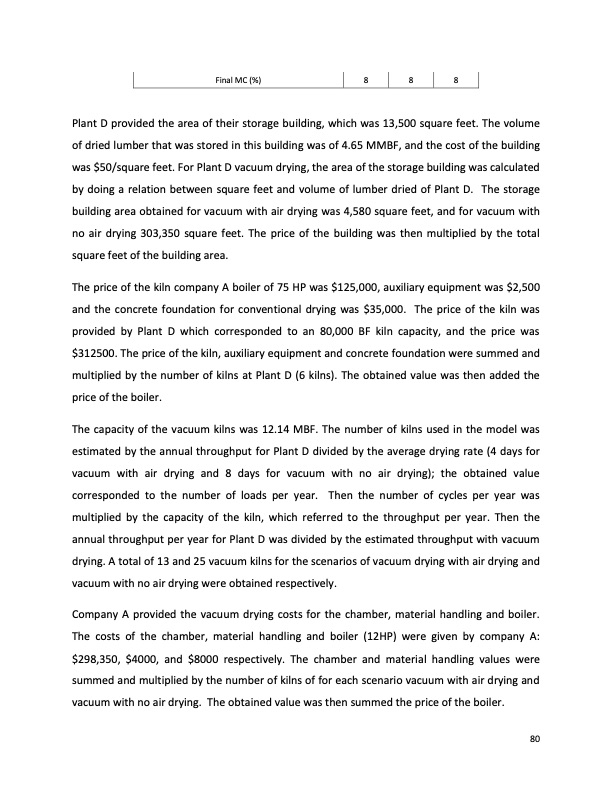
PDF Publication Title:
Text from PDF Page: 090
8 8 Final MC (%) 8 Plant D provided the area of their storage building, which was 13,500 square feet. The volume of dried lumber that was stored in this building was of 4.65 MMBF, and the cost of the building was $50/square feet. For Plant D vacuum drying, the area of the storage building was calculated by doing a relation between square feet and volume of lumber dried of Plant D. The storage building area obtained for vacuum with air drying was 4,580 square feet, and for vacuum with no air drying 303,350 square feet. The price of the building was then multiplied by the total square feet of the building area. The price of the kiln company A boiler of 75 HP was $125,000, auxiliary equipment was $2,500 and the concrete foundation for conventional drying was $35,000. The price of the kiln was provided by Plant D which corresponded to an 80,000 BF kiln capacity, and the price was $312500. The price of the kiln, auxiliary equipment and concrete foundation were summed and multiplied by the number of kilns at Plant D (6 kilns). The obtained value was then added the price of the boiler. The capacity of the vacuum kilns was 12.14 MBF. The number of kilns used in the model was estimated by the annual throughput for Plant D divided by the average drying rate (4 days for vacuum with air drying and 8 days for vacuum with no air drying); the obtained value corresponded to the number of loads per year. Then the number of cycles per year was multiplied by the capacity of the kiln, which referred to the throughput per year. Then the annual throughput per year for Plant D was divided by the estimated throughput with vacuum drying. A total of 13 and 25 vacuum kilns for the scenarios of vacuum drying with air drying and vacuum with no air drying were obtained respectively. Company A provided the vacuum drying costs for the chamber, material handling and boiler. The costs of the chamber, material handling and boiler (12HP) were given by company A: $298,350, $4000, and $8000 respectively. The chamber and material handling values were summed and multiplied by the number of kilns of for each scenario vacuum with air drying and vacuum with no air drying. The obtained value was then summed the price of the boiler. 80PDF Image | Impact of Vacuum-Drying on Efficiency of Hardwood Products

PDF Search Title:
Impact of Vacuum-Drying on Efficiency of Hardwood ProductsOriginal File Name Searched:
Brenes_Angulo_OM_T_2014.pdfDIY PDF Search: Google It | Yahoo | Bing
5,000 BF Shipping Container Lumber Dry Kiln For Quality Lumber The 5,000 BF container kiln consists of one 40 foot high-cube aluminum shipping container... More Info
Shipping Container Lumber Dry Kilns by Global Energy Global Energy designed and developed the container kiln back in 1991. The purpose is to give access to portable sawmill owners, furniture makers, and small business the value added profit of dry kiln lumber and quality hardwoods... More Info
Vacuum Kiln Conversion Kit for Lumber and Wood Dry Kilns Convert your existing conventional dry kiln into a fast drying vacuum kiln. Similar to vacuum bagging in the boat building and aircraft industry, we have come up with a proprietary process which allows you to build a very simple vacuum kiln at a fraction of the price, and without the intensive conventional metal chamber structure... More Info
Vacuum Pump Cart System for Bagging Clamping Wood Drying and more Vacuum Cart with 2HP Pump and Dual Pistons with multiple multiplex vacuum ports and liquid reservoir... More Info
Vacuum Bagging Basics Vacuum bagging is a method of clamping, which has traditionally been used in the composites industry, but can also be used for vacuum drying materials, including wood products... More Info
| CONTACT TEL: 608-238-6001 Email: greg@globalmicroturbine.com | RSS | AMP |